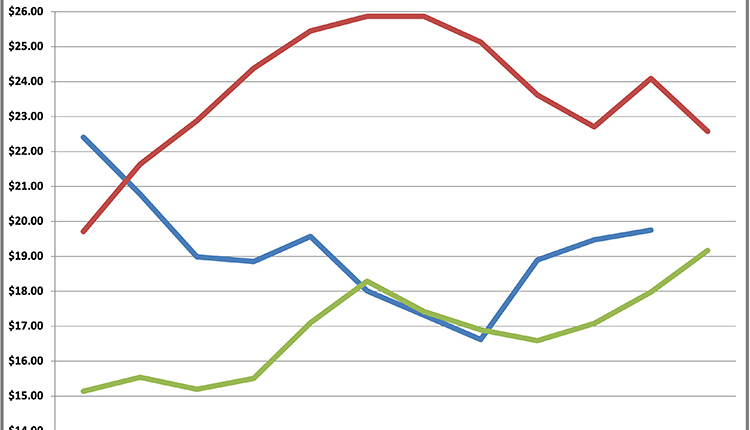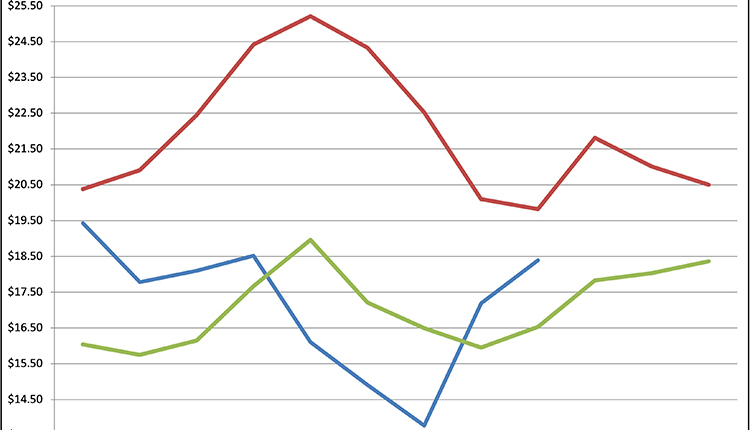As printed in our August 25, 2017 issue . . .
BUTTERFAT PRICES SURGED to $2.95 per pound this July, reported Federal Milk Marketing Order administrators. At the same time, milk protein values fell to a 16-year market low at $1.2248 per pound.
WITH NEWFOUND CONSUMER INTEREST in higher fat dairy foods, butterfat has shifted to contributing north of 50 percent to the All-Milk price. For additional perspective, see page 501 in this issue.
LOWER MILK PRICES IN 2016 meant higher operating losses for Western dairies, reported Genske, Mulder & Company. All areas in the summary lost money, but Upper Plains states and Texas lost much less of it. California and Colorado, on the other hand, lost a lot more of it.
WHILE FEED COSTS DROPPED steadily from $11.25 to $8.66 per hundredweight from 2013 to 2016, labor climbed from $1.53 to $1.77 per cwt. The herds averaged 2,188 cows throughout in this Western study.
WITHIN CALIFORNIA, the cost to produce milk fell to $17.30 per cwt. during the first quarter of 2017. It was down $1.14 per cwt. from the same time last year and that was the lowest cost of production figure since 2011, according to the California Department of Food and Agriculture.
AT $9.33, JUNE’S MILK MARGINS after feed costs climbed to the best levels since March as calculated by USDA’s Margin Protection Program (MPP-Dairy). In January, margins had reached a 2017 best of $11.06.
CME CLASS III FUTURES AVERAGED $17 for the final four months of the year. Meanwhile, January to June 2018 contracts traded near $16.60 with a range $16.58 to $16.74 during mid-August trading activity.
A $16.50 TO $16.75 MILK PRICE was projected by New Zealand’s Fonterra dairy cooperative for the upcoming 2017 to 2018 season. Down under, dairy farmers would be paid $6.75 per kilogram of milk solids.
U.S. DAIRY EXPORTS REACHED a three-year high in June. Volume rose 5 percent while dollar value jumped 26 percent. Through the first half of the year, dollar value grew 23 percent, volume 13 percent.
MILK REMAINS PLENTIFUL despite growing sales. “The combination of heavy milk supplies, disruptions at several processing facilities, and difficulty moving milk to alternative facilities . . . has led to some distressed milk moving at $4 to $5 under class,” wrote Dairy Market News editors.
PLANT EXPANSIONS ARE UNDERWAY: Valley Queen Cheese, Milbank, S.D., will increase capacity by 25 percent to reach 5-plus million pounds a day; AMPI will grow its Sanborn, Iowa, plant from a 1.4 to a 3 million-pound-a-day capacity; Bongard’s Creameries will invest $35 million in its Humboldt, Tenn., facility, while Upstate Niagara acquired the Kraft-Heinz plant in Campbell, N.Y., and will modernize it.
In your next issue . . .
MAILBOX PRICES REALLY REPRESENT FARMER MILK CHECKS.
With 75 to 95 percent of milk checks included in some regions, USDA’s mailbox price series accurately reflect dairy farmers’ “take-home pay.”
DISEASES THAT CREEP.
Don’t let unwanted health risks sneak on to your dairy.
A SEAT AT THE PRESIDENT’S TABLE.
A Michigan dairy farmer welcomed the chance to discuss agriculture with the President of the United States.









